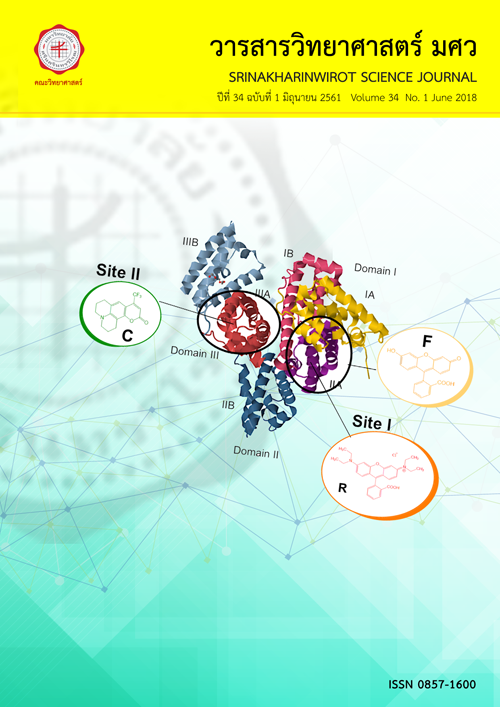การศึกษาแรงสั่นสะเทือนอัลตร้าโซนิคช่วยในการตัดอะลูมิเนียมหล่อ
Keywords:
Cutting force, Surface roughness, Ultrasonic vibration-assisted milling, Aluminum A356Abstract
บทคัดย่อ การประยุกต์ใช้แรงสั่นสะเทือนอัลตร้าโซนิคในงานกัดสามารถช่วยในการปรับปรุงลักษณะเฉพาะในการขึ้นรูปหลายๆ ด้าน เช่น แรงในการตัดเฉือน ความหยาบผิวของชิ้นงาน และอายุการใช้งานของเครื่องมือตัด อย่างไรก็ตาม จำนวนงานวิจัยในด้านนี้ยังมีอยู่ไม่มากและส่วนใหญ่เป็นการศึกษาวัสดุประเภทแข็งเปราะ ดังนั้น งานวิจัยนี้ได้ขยายขอบเขตการศึกษาในงานกัดอะลูมิเนียมหล่อเกรด A356 ซึ่งมีสมบัติอ่อนเหนียว โดยสร้างแรงสั่นสะเทือนความถี่ 19.74 กิโลเฮิรตซ์ ขนาดแอมพลิจูด 12 ไมโครเมตร ส่งผ่านให้กับชิ้นงานในทิศทางการเคลื่อนที่ของเครื่องมือตัด งานกัดถูกทำขึ้นภายใต้เครื่องกัดซีเอ็นซีและดอกเอ็นมิลคาร์ไบด์ขนาดเส้นผ่านศูนย์กลาง 6 มิลลิเมตร กัดแบบร่องปราศจากการหล่อเย็น ผลการทดลองพบว่า อัตราการป้อนสูงขึ้นส่งผลให้ค่าเฉลี่ยแรงตัดเฉือนในแนวระนาบของการใช้แรงสั่นสะเทือนอัลตร้าโซนิคมีค่าน้อยกว่ากระบวนการกัดแบบทั่วไปถึงร้อยละ 13.9 ลักษณะโครงสร้างจุลภาคของพื้นผิวงานหลังประยุกต์แรงสั่นสะเทือนอัลตร้าโซนิคมีการก่อตัวที่เป็นแบบแผนและแตกต่างจากกระบวนการกัดแบบทั่วไป เมื่อความเร็วในการตัดเฉือนเพิ่มสูงขึ้นค่าความหยาบผิวลดลงร้อยละ 21.4 สรุปได้ว่าแรงสั่นสะเทือนอัลตร้าโซนิคสามารถก่อให้เกิดผลกระทบเชิงบวกต่อค่าเฉลี่ยแรงตัดเฉือนและค่าความหยาบผิวโดยขึ้นอยู่กับอัตราการป้อนต่อฟันและความเร็วในการตัดเฉือน - - - Study of Ultrasonic Vibration Assisted Milling of Casted Aluminum ABSTRACT Ultrasonic vibration-assisted milling (UAM) has been proven to improve machining characteristics such as cutting force, surface roughness quality, and cutting tool life. However, the number of research studies in the field of UAM is very small and mainly focused on hard-brittle material machining processes. Accordingly, to expand UAM research into a wider variety of materials, a study of UAM on a ductile material, A356 Cast aluminum is presented in this research. In the experiment, ultrasonic vibration of 19.74 kHz with an amplitude of 12 µm was applied to the workpiece along cutting feed direction. Besides, CNC machining center and carbide end mill with a diameter of 6 millimeters were used for slot milling under dry cutting condition. Characteristics of cutting force magnitude in end mill revolution, surface topography, and surface roughness were compared between UAM and conventional milling (CM). Experimental results showed that the average horizontal force in cutting direction of UAM was lower than CM at large feed per tooth value by 13.9%. UAM surface topography was different when comparing to CM because ultrasonic vibration assistance enables the generation of a uniformed pattern on the workpiece. Surface roughness was improved by 21.4% when cutting speed increases. It was concluded that UAM application on A356 Cast aluminum material has positive effects on cutting force and surface roughness depending on feed per tooth and cutting speed.Downloads
Download data is not yet available.
Downloads
Published
2018-04-11
How to Cite
อุดมบุญญานุภาพ เ., เพ็งจันทร์ดี ธ., มุตตามะระ อ., & ศิวดำรงพงศ์ ส. (2018). การศึกษาแรงสั่นสะเทือนอัลตร้าโซนิคช่วยในการตัดอะลูมิเนียมหล่อ. Science Essence Journal, 34(1), 59–73. Retrieved from https://ejournals.swu.ac.th/index.php/sej/article/view/9447
Issue
Section
Research Article








